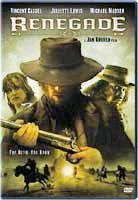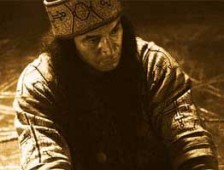The movie Blueberry is an adaptation of a Western comic book series written by Jean-Michel Charlier and illustrated by Jean Giraud, also known as Moebius, a science-fiction artist of considerable distinction. The movie is loosely based on two issues of these comic books — so loosely, in fact, that the film was disowned by the family of the deceased Charlier.
 |
Director Jan Kounen’s film certainly has the revenge-driven plot and the gorgeous cinematography of a modern Western movie. There is the typical one-street town with its saloon and brothel, gunfights, and a chase between cowboys and Indians. Indeed, since the Blueberry comics were little known in the United States, the American DVD was released under the title Renegade and marketed very much like a conventional Western.
The story begins when a young Mike Blueberry, a Louisiana Cajun, falls in love with a prostitute in the wild west town of Palomito. His true love dies during an inconclusive shootout between Blueberry and the despicable Wally Blount, the prostitute’s abusive boyfriend. Mourning his love, and nursing a mysterious secret about her death, Blueberry goes off to be healed and adopted by the Apache, forming a close friendship with the shaman Runi.
Years pass, and Blueberry has now become the marshall of Palomito, given the mission of maintaining peace between the settlers and the Apache. But a Prussian geologist finds an old Spanish map indicating gold deposits in the Apache sacred mountains, the townspeople get greedy, and — you knew this was coming — Blueberry’s old enemy Wally Blount comes to town, now revealed as a “white sorcerer.”
There is, of course, a showdown, during which the mysterious secret of the true love’s death is revealed. But the showdown does not take place on the dusty street, but in a great redemptive shamanic battle during Blueberry’s ayahuasca vision.
Wait a minute. Ayahuasca? Where did the Apache shaman Runi get ayahuasca? And why is he wearing a Shipibo hat and shirt?
 |
What had started as a straightforward adaptation of a Western comic book suddenly changed course when, during filming in Peru, Kounen met with famed Shipibo shaman Guillermo Arévalo — called by the name Kestenbetsa — and drank ayahuasca, apparently on numerous occasions. This experience seems to have had a profound effect on him, and he transposed the climactic action from the streets of Palomito to the spiritual space created by ayahuasca.
One critic has called the film a deconstruction of the Western form. But the film retains the classic Western themes — the battle of good and evil, the quest for redemption, the recovery of innocence, the solitary hero, the need for courage. While Blueberry pays homage in many ways to Alexandro Jodorowski’s El Topo, it remains in the lineage of Fred Zinnemann’s High Noon and Akira Kurosawa’s Yojimbo.
The film was not a critical success. Most critics hated it; one called it Indiana Jones and the Bad Peyote Trip. And, in fact, it is not difficult to see where Shipibo cultural elements have been interpolated into scenes apparently shot earlier, and there is a tension between representations of Shipibo shamanism and what seems to have been the earlier vague generic nature mysticism attributed to the Apache. Similarly, for Blount, the true treasure at the end of the movie turns out to be not gold but ayahuasca, which apparently he could find only with the aid of the ancient map.
But the film has attained something of a cult status for psychonauts of various kinds, especially for its depiction of Blueberry’s climactic ayahuasca experience. James Kent, the former editor of Entheogen Review and Trip magazine, says that it is the best psychedelic western ever, which certainly puts it first in a small field.
There are, in fact, two scenes in which Blueberry drinks ayahuasca — one a brief excursion to get his bearings, and the other the great showdown with the sorcerer Blount. Both use CGI computer animation in an attempt to reproduce the ayahuasca experience. These sequences, like the movie, have received mixed reviews, and have been called intense, beautiful, and as boring as watching a screensaver. Judge for yourself. Here is the climactic battle:
Jan Kounen later went on to make a documentary, Other Worlds (D’autres mondes), about Shipibo culture and shamanism. An interview with Kounen about his Shipibo experiences was published in Filmmaker Magazine. The hour-long documentary is remarkable, and has now most generously been made available in its entirety:

- Previous Post: Who is a Shaman?
- Next Post: Ethical Wildcrafting
- More Articles Related to: Ayahuasca, Books and Art, Shamanism



The “Other Worlds” documentary is excellent–well worth one’s time and attention. Thanks for pointing it out.
I haven’t seen Renegade. But after viewing Darron Aronofsky’s “The Fountain” I was convinced it was inspired by ayahuasca. It was generally panned by critics. But I loved it for its evocation–for me– of the haunting poetry, the heart-breaking love and the nonlinear layers of meaning that can be found in a journey with the sacred vine.
One must just read the Shilam Balam and the Amoxtlis to understand that in “The Fountain” are portrayed the Hunab Kuh of the Mayan and the Omeyocan of the Mexica and the Water Way of the Dine. Great movie indeed!
It´s impossible to put an ayahuasca experience in a screen. But this is the closest you could get. Ask anyone who has done ayahuasca